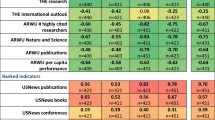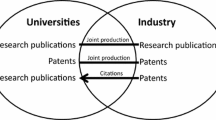Abstract
The academic ranking process has considerably evolved in the past fifteen years and the evolution has gained the momentum in last few years. Starting with the holistic rankings of world universities in 2003, it has crossed the milestone of subject-specific rankings. Nevertheless, the academic rankings published by even the reputed ranking entities are facing various criticism, in terms of their transparency, validity, and coverage. This research effort focuses on enhancing the credibility of the ranking process through the fine-grained analysis of the academic data. The proposed fine-grained analysis drives the researcher’s profiles from the Google Scholar Citations repository. While the DBpedia repository is employed for the information about HEIs and countries. The influential researchers are identified using the ResRank methodology. While, for consistent comparison of the subject-specific rankings of global HEIs, the Grand Average Rank (GAR) metric is employed. The resultant academic rankings with respect to the Research Faculty, Research Productivity, and Research Impact make the ranking process more transparent and fine-grained. The analysis also helps in understanding the causes of differences among the academic rankings published by the ARWU, THE, and QS rankings systems. The growing interest in the subject-specific and sub-discipline-specific rankings is irreversible. The fine-grained analysis is a response to the need.












Similar content being viewed by others
Notes
References
Federkeil (2011). Rankings and quality assurance in higher education. Higher Education in Europe, 33(2), 219–231,. http://dx.doi.org/https://doi.org/10.1080/03797720802254023.
Qureshi, M. S., Daud, A., Hayat, M. K., & Afzal, M. T. (2021). OpenRank—A novel approach to rank universities using objective and publicly verifiable data sources. Library Hi-Tech, 39(1).
Lokman, I. M. (2020). Highly prestigious international academic awards and their impact on university rankings. Quantitative Science Studies, 1(2), 824–848.
Abramo, G., Andrea, D. C., & Soldatenkova, A. (2016). The ratio of top scientists to the academic staff as an indicator of the competitive strength of universities. JournalofInformetrics, 10, 596–605.
Fredrik, N. P., & Gunnar, S. (2016). How can differences in international university rankings be explained? Scientometrics, 109(3), 2263–2278.
Lin, C.-S., Huang, M.-H., & Chen, D.-Z. (2013). The Influences of Counting Methods on University Rankings Based on Paper Count and Citation Count. Journal of Informetrics, 7, 611–621. https://doi.org/10.1016/j.joi.2013.03.007
Jo, A. O. (2019). The “Dark Side” of Academics? Emerging Issues in the Gaming and Manipulation of Metrics in Higher Education. The Review of Higher Education, 42(3), 859–877.
Henk, F., & Moed (2016). A critical comparative analysis of five world university rankings, Scientometrics, 110(2), 967–990.
Friso, S., Cameron, N., Chun-Kai, H., & Paul, G. (2020). A Longitudinal analysis of university rankings. Quantitative Science Studies, 1(3), 1109–1135.
Aguillo, I. F., & Bar-Ilan, J. (2010). Comparing University Rankings. Journal of Scientometrics, 85, 243–256.
Garcia, R., & Herrera, F. (2013). An Insight into the Importance of National University Rankings in an International Context. In ISSI Conference, Vienna.
Huang, C.-K., Neylon, C., Brookes-Kenworthy, C., Hosking, R., Montgomery, L., Wilson, K., & Ozaygen, A. (2020). Comparison of bibliographic data sources: Implications for the robustness of university rankings. Quantitative Science Studies, 1(2), 445–478.
Ortega, J. L. (2014). Influence of co-authorship networks in the research impact Ego network analyses from Microsoft Academic Search. Journal of Informetrics, 8, 728–737.
Yang, B., Ronald, R., Shuiqing, H., & Sulan, Y. (2015). Do first rate scientists work at first rate organizations? Malaysian Journal of Library & Information Science, 20(1), 47–60.
Giovanni, A., & Ciriaco, A. D. (2015). Ranking research institutions by the number of highly-cited articles per scientist. Journal of Informetrics, 9, 915–923.
Mingers, J., O’Hanley, J. R., & Okunola, M. (2017). Using Google Scholar institutional level data to evaluate the quality of university research. Scientometrics, 113, 1627–1643.
Jabnoun, N. (2015). The influence of wealth, transparency, and democracy on the number of top ranked universities. Quality Assurance in Education, 23(2), 108–122.
Sheeja, N. K., Mathew, S., & Cherukodan, S. (2018). Impact of scholarly output on university ranking,". Global Knowledge, Memory and Communication, 67(3), 154–165.
Jun, Z., Bo, X., Jiaying, L., Amr, T., & Al, Z. (2018). PePSI: Personalized Prediction of Scholars’ Impact in Heterogeneous Temporal Academic Networks, IEEE ACCESS.
Koen, F., Gaston, J. H., & Jarno, H. (2017). What drives university research performance? An analysis using CWTS Leiden Ranking data. Journal of Informetrics, pp. 859–872.
Uslu, B. (2020). A path for ranking success: What does the expanded indicator-set of international university rankings suggest? Higher Education, 80, 949–972.
Maxime, M., & Alex, P. J. (2018). Engineering the global university rankings: Gold standards, Limitations and Implications. IEEE Acess, vol. 6
Boulton, G. (2011). University Rankings: Diversity, Excellence and the European Initiative. Science Direct Procedia Social and Behavioral Sciences, 13, 74–82.
Luis, O. (2014). Influence of co-authorship networks in the research impact: Ego network analyses from Microsoft Academic Search. Journal of Informetrics, 8(3), 728–737.
Heath, B. C., & Lee, T. B. (2009). Linked Data - The Story So Far. International Journal on Semantic Web and Information Systems, 5(3), 1–22.
Meymandpour, R., & Davis, J. G. (2016). A semantic similarity measure for linked data: An information content-based approach. Knowledge-Based Systems.
Holst, T., & Höfig, E. (2013). Investigating the relevance of linked open data sets with SPARQL queries. In 37th Annual Computer Software and Applications Conference Workshops, Berlin Heidelberg, https://doi.org/10.1109/COMPSACW.2013.31
Huang, C.-K., Cameron, N., Chloe, B.-K., Richard, H., Lucy, M., Katie, W., & Alkim, O. (2020). Comparison of bibliographic data sources: Implications for the robustness of university rankings. Quantitative Science Studies, 1(2), 445–478.
Nicolas, R.-G., Daniel, T.-S., Enrique, H.-V., & Domingo, D. (2019). Mining university rankings: Publication output and citation impact as their basis. Research Evaluation, 28(3), 232–240.
Xuanyu, C., Yan, C., & R. L. K.J. (2016) A data analytic approach to quantifying scientific impact. Journal of Informetrics, 10(2): 471–484
Hirsch, J. E. (2005). An index to quantify an individual's scientific research
Ferrara, E., & Romero, A. (2013). Scientific impact evaluation and the effect of self-citations: Mitigating the bias by discounting the h-index. Journal of the American Society for Information Science and Technology, 64(11), 2332–2339.
Lutz, B., & Daniel-Dieter, H. (2007). What do we know about the h-index? Journal of the American Society for Information Science and Technology, 59(9), 1381–1385.
Daud, A., Li, J., Zhou, L., & Muhammad, F. (2010). Temporal expert finding through generalized time topic modeling. Knowledge-Based Systems, 65(9), 70–81.
Amjad, T., Ding, Y., Xu, J., Zhang, C., Tang, J., Song, M., & Daud, A. (2017). Standing on the shoulders of giants. Journal of Informetrics, 11, 307–323.
Zhang, F., Bai, X., & Lee, I. (2019). Author impact: evaluations, predictions, and challenges. IEEE Access, pp. 125–138.
Dewi Ahmad, W., & Abu Bakar, A. (2018). Classification models for higher learning scholarship award decisions. Asia-Pacific Journal of Information Technology and Multimedia, 7(2), pp. 131–145.
Wu, X., Kumar, V., & Quinlan, J. R. (2008). Top 10 algorithms in data mining. Knowledge Informaton System, 14, 1–37.
Jamil, S. (2009). The challenge of establishing world-class universities., WashingtonDC: TheWorldBank. ,ISBN978–0–8213–7865–6.
Author information
Authors and Affiliations
Corresponding author
Rights and permissions
About this article
Cite this article
Qureshi, M.S., Daud, A. Fine-grained academic rankings: mapping affiliation of the influential researchers with the top ranked HEIs. Scientometrics 126, 8331–8361 (2021). https://doi.org/10.1007/s11192-021-04138-z
Received:
Accepted:
Published:
Issue Date:
DOI: https://doi.org/10.1007/s11192-021-04138-z




